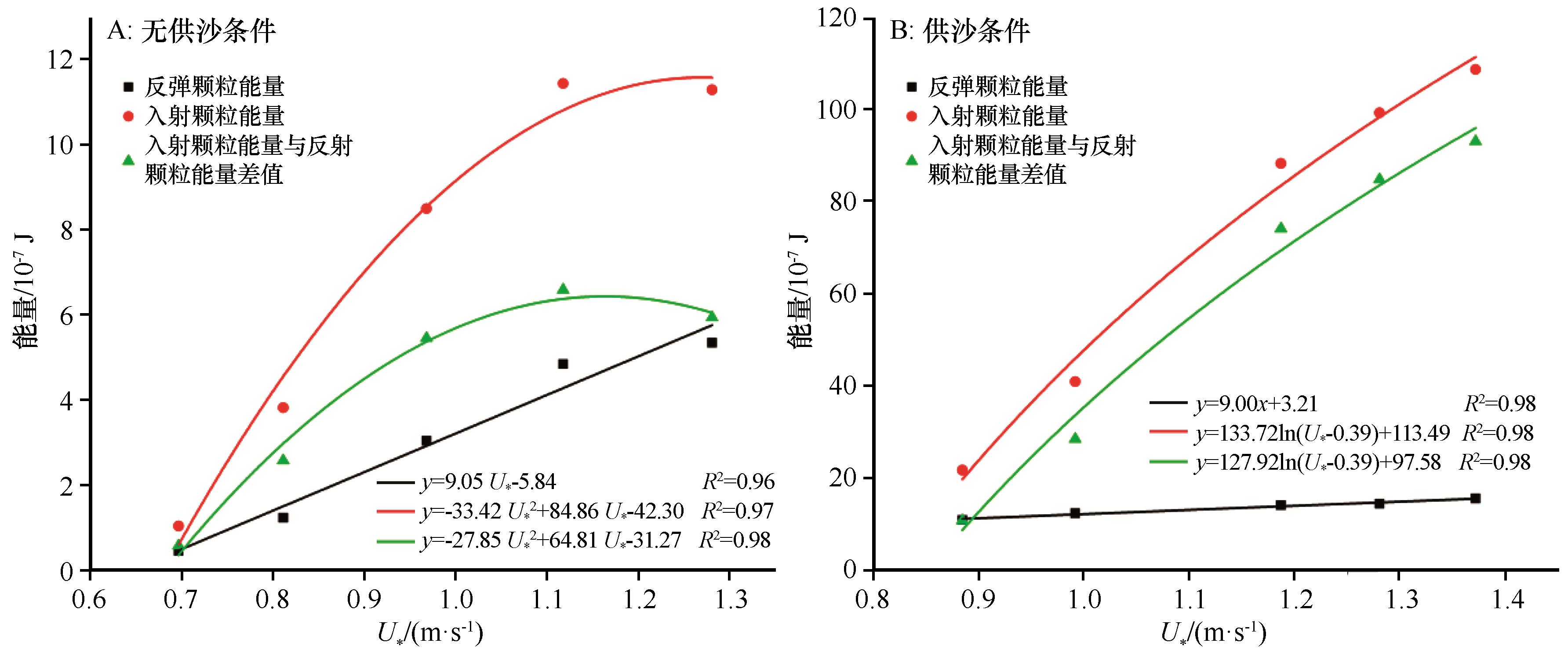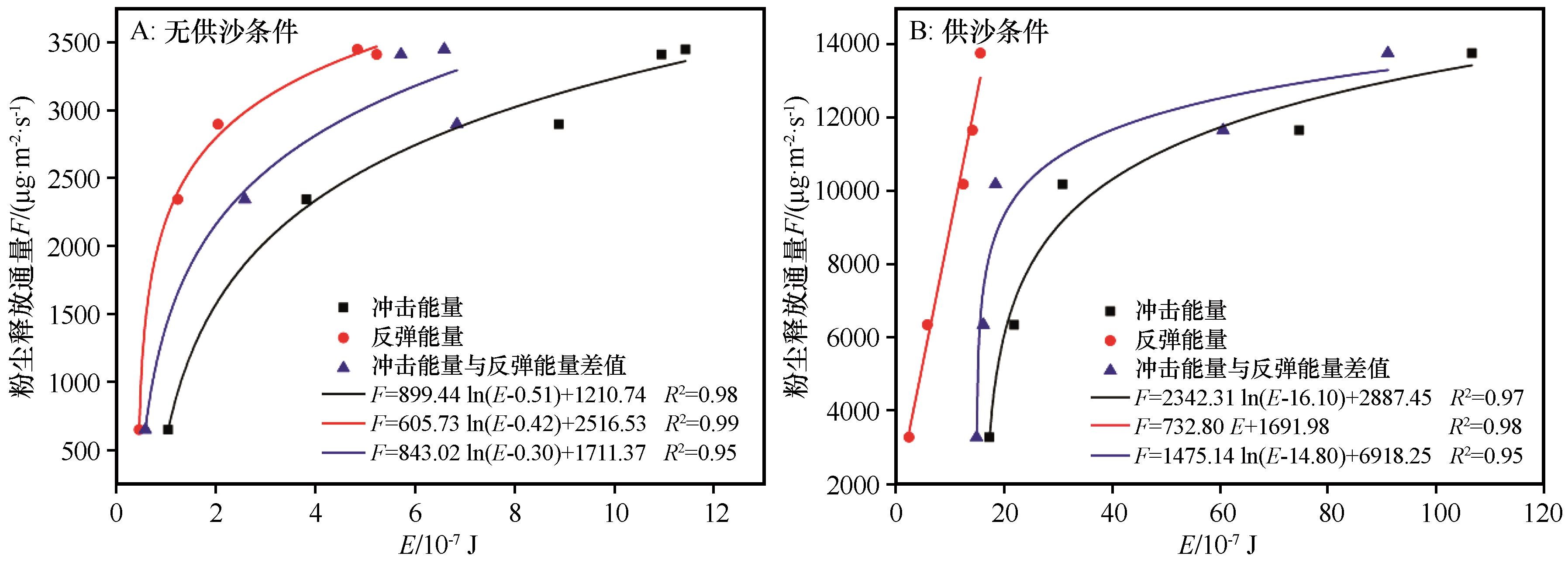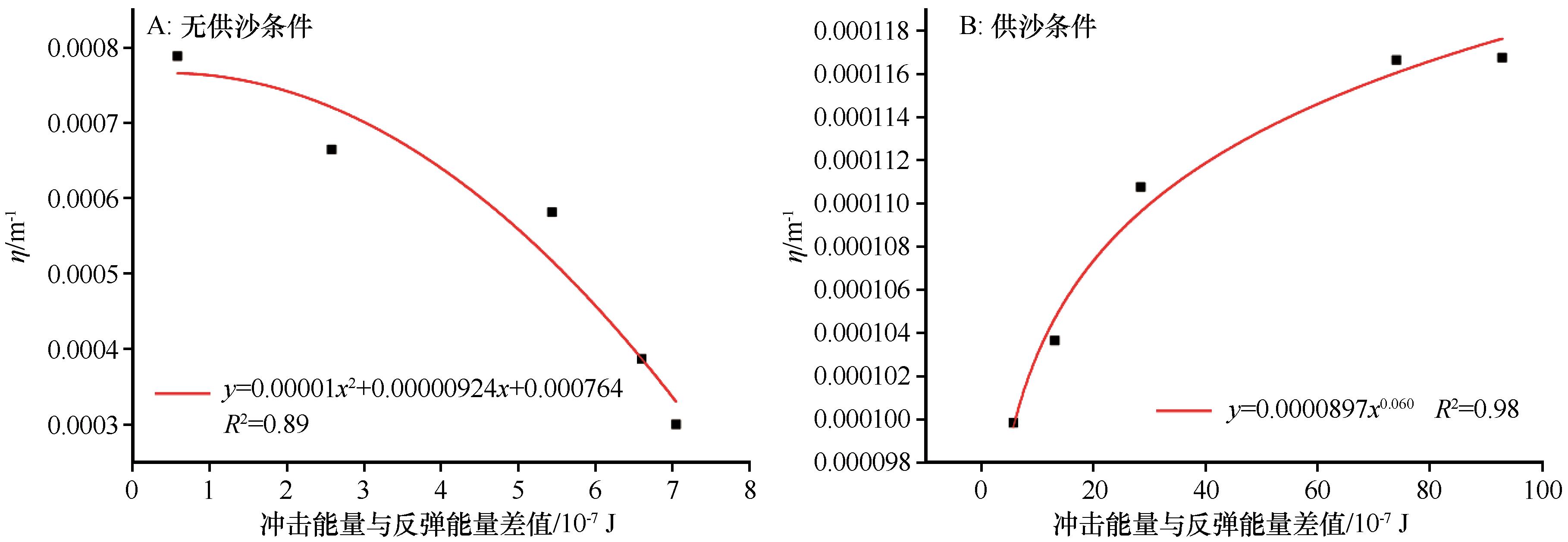
- CN 62-1070/P
- ISSN 1000-694X
- Bimonthly 1981

Journal of Desert Research ›› 2023, Vol. 43 ›› Issue (2): 216-225.DOI: 10.7522/j.issn.1000-694X.2023.00016
Previous Articles Next Articles
Shuyi Chen1,2( ), Weimin Zhang1, Shaoxiu Ma1, Lihai Tan1, Linhao Liang1,2
), Weimin Zhang1, Shaoxiu Ma1, Lihai Tan1, Linhao Liang1,2
Received:2022-12-21
Revised:2023-01-27
Online:2023-03-20
Published:2023-04-12
CLC Number:
Shuyi Chen, Weimin Zhang, Shaoxiu Ma, Lihai Tan, Linhao Liang. Study on dynamic mechanism of dust emission from gobi based a portable wind tunnel experiment atop the Mogao Grottoes, Dunhuang, China[J]. Journal of Desert Research, 2023, 43(2): 216-225.
Add to citation manager EndNote|Ris|BibTeX
URL: http://www.desert.ac.cn/EN/10.7522/j.issn.1000-694X.2023.00016
| 样品 | 极粗砂 1~2 mm | 粗砂 0.5~1.0 mm | 中砂 0.25~0.5 mm | 细砂 0.125~0.250 mm | 极细砂 0.063~0.125 mm | 细粒 <0.063 mm |
|---|---|---|---|---|---|---|
| 戈壁1 | 17.1 | 10.5 | 4.7 | 24.6 | 34.4 | 8.6 |
| 戈壁2 | 8.4 | 6.2 | 12.1 | 39.3 | 26.4 | 7.6 |
| 沙丘沙 | 0.5 | 11.9 | 68.2 | 17.9 | 1.5 |
Table 1 Grain size composition of gobi and sand dune atop the grottoes (%)
| 样品 | 极粗砂 1~2 mm | 粗砂 0.5~1.0 mm | 中砂 0.25~0.5 mm | 细砂 0.125~0.250 mm | 极细砂 0.063~0.125 mm | 细粒 <0.063 mm |
|---|---|---|---|---|---|---|
| 戈壁1 | 17.1 | 10.5 | 4.7 | 24.6 | 34.4 | 8.6 |
| 戈壁2 | 8.4 | 6.2 | 12.1 | 39.3 | 26.4 | 7.6 |
| 沙丘沙 | 0.5 | 11.9 | 68.2 | 17.9 | 1.5 |

Fig.3 The fitting relationship between impact energy, rebounding energy and their difference and friction wind speed under no sand supply condition (A) and sand supply condition (B)

Fig.4 The fitting relationship between the impact, rebounding energy and their difference and dust release flux under no sand supply condition (A) and sand supply condition (B)
| 无供沙条件 | 供沙条件 | |||||||||
|---|---|---|---|---|---|---|---|---|---|---|
| U*/(m·s-1) | 0.69 | 0.84 | 0.96 | 1.12 | 1.28 | 0.77 | 0.88 | 1.01 | 1.24 | 1.37 |
| F/(μg·m-2·s-1) | 649.41 | 2 343.13 | 2 896.64 | 3 446.79 | 3 409.74 | 3 277.62 | 6 349.68 | 10 188.32 | 12 407.25 | 13 772.68 |
| 冲击能量/×10-7 J | 1.04 | 3.82 | 8.48 | 11.44 | 11.28 | 14.40 | 24.08 | 40.90 | 88.20 | 108.56 |
| F/冲击能量 | 624.44 | 613.39 | 341.59 | 301.29 | 302.28 | 227.62 | 263.69 | 249.11 | 140.67 | 126.865 |
| 反弹能量/×10-7 J | 0.46 | 1.24 | 3.04 | 4.84 | 5.23 | 8.63 | 10.93 | 12.41 | 14.11 | 15.58 |
| F/反弹能量 | 1 411.76 | 1 889.62 | 952.84 | 712.14 | 651.95 | 379.79 | 580.94 | 820.97 | 879.32 | 883.99 |
Table 2 Comparison of gobi dust emission flux and impact, rebounding energy under no sand supply condition and sand supply condition
| 无供沙条件 | 供沙条件 | |||||||||
|---|---|---|---|---|---|---|---|---|---|---|
| U*/(m·s-1) | 0.69 | 0.84 | 0.96 | 1.12 | 1.28 | 0.77 | 0.88 | 1.01 | 1.24 | 1.37 |
| F/(μg·m-2·s-1) | 649.41 | 2 343.13 | 2 896.64 | 3 446.79 | 3 409.74 | 3 277.62 | 6 349.68 | 10 188.32 | 12 407.25 | 13 772.68 |
| 冲击能量/×10-7 J | 1.04 | 3.82 | 8.48 | 11.44 | 11.28 | 14.40 | 24.08 | 40.90 | 88.20 | 108.56 |
| F/冲击能量 | 624.44 | 613.39 | 341.59 | 301.29 | 302.28 | 227.62 | 263.69 | 249.11 | 140.67 | 126.865 |
| 反弹能量/×10-7 J | 0.46 | 1.24 | 3.04 | 4.84 | 5.23 | 8.63 | 10.93 | 12.41 | 14.11 | 15.58 |
| F/反弹能量 | 1 411.76 | 1 889.62 | 952.84 | 712.14 | 651.95 | 379.79 | 580.94 | 820.97 | 879.32 | 883.99 |

Fig.5 The relationship between gobi bombardment efficiency and the difference between impact energy and rebounding energy under no sand supply condition (A) and sand supply condition (B)
| 1 | Zhang W M, Tan L H, Liang L H,et al.Dynamic processes of dust emission from gobi:a portable wind tunnel study atop the Mogao Grottoes,Dunhuang,China[J].Aeolian Research,2022,55:100784. |
| 2 | 张正偲,潘凯佳,梁爱民,等.戈壁沙尘释放过程与机理研究进展[J].地球科学进展,2019,34(9):891-900. |
| 3 | Wang X, Lang L, Hua T,et al.Characteristics of the gobi desert and their significance for dust emissions in the Ala Shan Plateau (Central Asia):an experimental study[J].Journal of Arid Environments,2012,81:35-46. |
| 4 | 邹学勇,董光荣,王周龙.戈壁风沙流若干特征研究[J].中国沙漠,1995,15(4):368-373. |
| 5 | Zhang Z C, Dong Z B, Li J Y,et al.Implications of surface properties for dust emission from gravel deserts (gobis) in the Hexi Corridor[J].Geoderma,2016,268:769-770. |
| 6 | 岑松勃,张春来,代豫杰,等.风蚀事件中农田土壤PM10释放特征[J].中国沙漠,2020,40(3):145-150. |
| 7 | 张正偲,潘凯佳,张焱,等.中国西北戈壁区沙尘暴过程中近地层风沙运动特征[J].中国沙漠,2023,43(2):130-138. |
| 8 | 孟小楠,严平,王振亭,等.车辆碾压作用下戈壁地表起尘浓度[J].中国沙漠,2019,39(1):80-87. |
| 9 | 谭立海,张伟民,屈建军,等.不同砾石覆盖度戈壁床面风蚀速率定量模拟[J].中国沙漠,2016,36(3):581-588. |
| 10 | Francesco C, Michael L.Energy and momentum conserving model of splash entrainment in sand and snow saltation[J].Geophysical Research Letters,2017,44(3):1601-1609. |
| 11 | Mitha S, Tran M Q, Werner B T,et al.The grain-bed impact process in aeolian saltation[J].Aeta Mechaniea,1986,63:267-278. |
| 12 | Huang N, Wang C, Pan X Y.Simulation of aeolian sand saltation with rotational motion[J].Journal of Geophysical Research,2010,115:D22211. |
| 13 | Rice M A, Mullins C E, Mcewan I K.An analysis of soil crust strength in relation to potential abrasion by saltating particles[J].Earth Surface Processes and Landforms,2015,22(9):869-883. |
| 14 | Rice M A, McEwan I K.Crust strength:a wind tunnel study of the effect of impact by saltating particles on cohesive soil surfaces [J].Earth Surface Processes and Landforms,2001,26(7):721-733. |
| 15 | Shao Y P, Raupach M R, Findlater P A.Effect of saltation bombardment on the entrainment of dust by wind[J].Journal of Geophysical Research Atmospheres,1993,98(D7):12719-12726. |
| 16 | Marticorena B, Bergametti G.Modeling the atmospheric dustcycle:1.design of a soil-derived dust emission scheme[J].Journal of Geophysical Research,1995,100(D8):16415-16430. |
| 17 | Alfaro S C, Gaudichet A, Gomes L,et al.Modeling the size distribution of a soil aerosol produced by sandblasting[J].Journal of Geophysical Research:Atmospheres,1997,102(D10):11239-11249. |
| 18 | Shao Y P.Simplification of a dust emission scheme and comparison with data[J].Journal of Geophysical Research,2004,109:D10202. |
| 19 | Kok J F.A scaling theory for the size distribution of emitteddust aerosols suggests climate models underestimate the size ofthe global dust cycle[J].Proceedings of the National Academy of Sciences,2011,108:1016-1021. |
| 20 | Willetts B B, Rice M A.Collision in Aeolian saltation[J].ActaMechanica,1986,63:255-265. |
| 21 | Greeley R G, Blumberg D G, Williams S H.Field measurements of the flux and speed of wind-blown sand[J].Sedimentology,1996,43:41-52. |
| 22 | Stout J E, Zobeck T M.Intermittent saltation[J].Sedimentology,1997,44:959-970. |
| 23 | Tan L H, An Z S, Zhang K,et al.Intermittent aeolian saltation over a gobi surface:threshold,saltation layer height and high frequency variability[J].Journal of Geophysical Research:Earth Surface,2020,125(1):e2019JF005329. |
| 24 | 黄翠华,张伟民,李爱敏.莫高窟窟顶风况及输沙势研究[J].中国沙漠,2006,26(3):394-398. |
| 25 | Shao Y P.Physical and Modeling of Wind Erosion [M].Berlin,Germany:Springer Press,2008. |
| 26 | Gillette D A, Blifford I H, Fenster C R.Measurements of aerosol size distributions and vertical fluxes of aerosols on land subject to wind erosion[J].Journal of Applied Meteorology,1972,11(6):977-87. |
| 27 | Nickling W G, Gillies J A.Dust emission and transport in Mali,West Africa [J].Sedimentology,1993,40:859-868. |
| 28 | Liang L H, Zhang W M, Tan L H,et al.Dust emission from gobi under different dust content conditions:a wind tunnel study atop the Mogao Grottoes[J].Atmosphere,2021,12(11):1498. |
| 29 | Shao Y P.A model for mineral dust emission[J].Journal of Geophysical Research Atmospheres,2001,106(D17):20239-20254. |
| 30 | Swet N, Elperin T, Kok J F,et al.Can active sands generate dust particles by wind-induced processes?[J].Earth and Planetary Science Letters,2019,506:371-380. |
| 31 | Houser C A, Nickling W G.The emission and vertical flux of particulate matter <10 μm from a disturbed clay‐crusted surface [J].Sedimentology,2010,48(2):255-267. |
| 32 | 张正偲,董治宝.土壤风蚀对表层土壤粒度特征的影响[J].干旱区资源与环境,2012,26(12):86-89. |
| 33 | Aimar S B, Mendez M J, Funk R,et al.Soil properties related to potential particulate matter emissions (PM10) of sandy soils [J].Aeolian Research,2012,3(4):437-443. |
| [1] | Rende Wang, Qing Li, Chunping Chang, Zhongling Guo, Jifeng Li, Xueyong Zou, Chunlai Zhang, Yixiao Yuan, Ying Liu, Na Zhou. Review of dust emission in soil wind erosion [J]. Journal of Desert Research, 2023, 43(2): 85-103. |
| [2] | Shufeng Qu, Guoming Zhang, Lianyou Liu, Li Li, Yuting Xiao, Mingzhu Xiang, Xuran Sun, Xujiao Han. The surface abrasion and dust emission of mud desert in dry rump lake basin [J]. Journal of Desert Research, 2022, 42(4): 81-88. |
| [3] | Yue Zhang, Siyu Chen, Hongru Bi, Jiahui Cao, Yuan Luo, Yongqi Gong, Yu Chen. Characteristics and parameterization of farmland soil wind erosion in arid and semi-arid areas of China: progress and challenges [J]. Journal of Desert Research, 2022, 42(3): 105-117. |
| [4] | Jiliang Liu, Wenzhi Zhao, Fengrui Li, Yibin Ba. Community dynamics of ground arachnid arthropods in a gravel gobi desert of the middle of the Hexi Corridor, China [J]. Journal of Desert Research, 2021, 41(3): 155-164. |
| [5] | Mingzhu Zhao, Ruiping Zu, Junzhan Wang, Lihai Tan. Grain size characteristics of sediment along the Hami-Lop Nor Railway [J]. Journal of Desert Research, 2021, 41(1): 19-27. |
| [6] | Fanmin Mei, Shan Wang, Lixuan Tang, Jin Su. An improved scheme for modeling wind friction threshold velocity dependent on the aspect ratio of individual element and aerodynamic roughness length [J]. Journal of Desert Research, 2020, 40(6): 98-104. |
| [7] | Liqiang Kang, Caiyun Li, Junjie Zhang, Xueyong Zou. Characteristics of instantaneous surface shear stress distribution at flexible plant surface [J]. Journal of Desert Research, 2020, 40(5): 49-56. |
| [8] | Suchao Li, Man Qiu, Xiaoze Li, Jingde Liu, Limin Wang, Yang Hu, Zhigang Li, Gaihong Niu. Characteristics, age and process of Mohetai alluvial fan gobi in the upper reaches of Baiyang River in the western margin of Junggar Basin, NW China [J]. Journal of Desert Research, 2020, 40(4): 1-9. |
| [9] | Xue Dong, Yonghua Li, Zhengguo Zhang, Siyao Li, Yanfeng Bao, Yuguang Hao, Bin Yao. Niche of dominant shrub species in desert gobi in Jiuquan, Gansu, China [J]. Journal of Desert Research, 2020, 40(4): 138-145. |
| [10] | Zhenqing Zhang, Binglin Zhang, Wei Zhang, Guangxiu Liu, Tuo Chen, Yang Liu, Jingwei Chen, Mao Tian. Distribution characteristics and anti-radiation activity of culturable bacteria in black gobi ecosystem of the Hexi Corridor [J]. Journal of Desert Research, 2020, 40(4): 52-62. |
| [11] | Cen Songbo, Zhang Chunlai, Dai Yujie, Zhang Hui, Liu Xinyu, Li Qing, Huang Yuhu. Characteristics of PM10 emission from farmland during a wind erosion event [J]. Journal of Desert Research, 2020, 40(3): 145-150. |
| [12] | Pan Kaijia, Zhang Zhengcai, Liang Aimin, Dong Zhibao, Li Xingcai. Nebkhas geomorphology in the gobi desert using the unmanned aerial vehicle and tilt camera [J]. Journal of Desert Research, 2020, 40(2): 24-32. |
| [13] | Kang Liqiang, Yang Zhicheng, Zhang Junjie, Zou Xueyong, Zhang Wen. Wind tunnel simulation for comparison of wind velocity profile characteristics at two flexible plant surfaces [J]. Journal of Desert Research, 2020, 40(2): 43-49. |
| [14] | Kang Liqiang, Gao Yongqing, Zhang Wen, Zou Xueyong. Characteristics of instantaneous sediment transport in steady aeolian sand transport [J]. Journal of Desert Research, 2020, 40(1): 166-172. |
| [15] | Li Kuan, Jia Xiaopeng, Xiong Xin, Wang Haibing, Li Gangtie. Potential of Dust Emission and Causes of Frequent Sandstorm Activities in Ejina Banner, Inner Mongolia, China [J]. Journal of Desert Research, 2019, 39(3): 191-198. |
| Viewed | ||||||
|
Full text |
|
|||||
|
Abstract |
|
|||||
©2018Journal of Desert Research
Tel:0931-8267545
Email:caiedit@lzb.ac.cn;desert@lzb.ac.cn
Support:Magtech